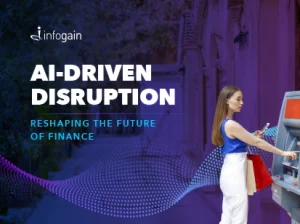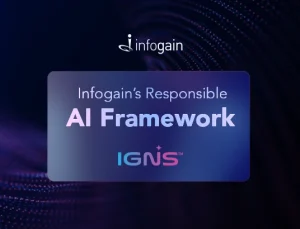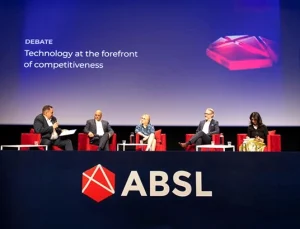- Posted on : March 31, 2017
-
- Industry : Digital and High Technology
- Type: News

“We help our customers not just with the strategy and understanding of the impact on their business, but also the design, planning, estimation and realization of changes at the process and technology levels”- Mr. Ramesh Subramanian, Chief Technology Officer, Infogain
“In an exclusive interview with ITVoice, Mr. Ramesh Subramanian,Chief Technology Officer, Infogain, sharing his business strategies.”
Megha Mary- Tell us more about Infogain
Mr. Ramesh Subramanian- Infogain is an IT Services & Consulting firmproviding technology solutions for Retail, Travel & Hospitality, High-Tech, Insurance and Healthcare vertical. The key statistics are: headquartered in Los Gatos, CA with offices across the world, 4000 consultants with about 25% located outside India. Our focus is on Digital Transformation in selected micro-verticals.
Megha Mary-The IT industry is facing challenges both in terms of automation, change in technology and sentiments in the US market. What are your views on that?
Mr. Ramesh Subramanian- In some respects, there have always been challenges to the industry- be it y2k, 9-11, the wars in middle-east, dot com bust, etc. etc.
Today, we’re facing a re-invention of business by the introduction of digital technology on an unprecedented scale: just about any business event or signal can be digitized, and that leads on one hand to automation, while on the other hand it does away with human interventions, and thereby human jobs.
We can see it as an enormous disruption to the “business as usual” way similar, but a lot more pervasive than the ERP revolution of the early 90s. Consulting companies heavily invested in technology such as ourselves see this as a tremendous opportunity, perhaps the biggest yet the rise of automation and intelligence embedded in software, and their participation in daily life is all too visible, and organizations are not all adept in adopting to these changes; our role becomes all the more valuable as guides, aides, managers and implementers.
At the same time, the potential rise of protectionism in our major markets in US also causes some changes in what we can and cannot offer or pursue as an opportunity. While we see these pressures escalating, we feel somewhat insulated on account of our lowerreliance on the work visas- the majority of our employees overseas are local residents and tax-payers. We believe most IT Services companies will have to shift to this model very soon.
Megha Mary-What are Infogain’s strategies to tackle such challenges?
Mr. Ramesh Subramanian- On one level, we see a rise in competition for talent in the US, and a higher reliance on training infrastructure from ourselves and our partners towards catching up with the skills demand. On another level, we see the tidal wave of new technologies, new processes, new concepts and models almost new languages in themselves creating enormous disruption in the industry spreading out from the US towards the more developed markets worldwide.
After all, who would want to have an old Feature Phone any more in preference to a Smart Phone?
We too will focus on recruitment of talent within the US to the extent it is reasonable. For situations where this is not easy to do, we will try to increase our ability to execute seamlessly across our various offices, rather than restrict ourselves to concepts such as “onsite” and “offshore”.
Megha Mary-High headcount and low cost model has lost its relevance in the IT sector – how true is this statement? Does it have any impact on Infogain?
Mr. Ramesh Subramanian- We feel the labor arbitrage model will play out for some time yet: our larger customers and large IT consumers worldwide are focused on tackling their business challenges, and technology is often relegated to “later” in the boardroom. This means large support/ AMS engagements, large implementations and rollouts, etc. will continue for perhaps a decade, but will continually taper off. These are the dinosaurs of our era, hanging on against the winds of change until the change becomes irresistible. While headcounts for IT engagements are seen to drop and engagement cycle times will crash, labour arbitrage may continue to be relevant: given the sheer competition in “enclaves” like Silicon Valley, talent anywhere else is seen as far more affordable and adaptable. Frequently, the arbitrage is seen to play out only if all other considerations tally- eg. the quality of outcomes must be comparable to a higher cost alternative. And the pace of technology change is now such that there are no “entrenched” companies that can display such expertise. The future belongs to the nimbler, smaller companies that can maintain their brand value and trust with their customers and prospects.
Megha Mary-It is said Automation and Intelligence is the way forward – what kind of investment is Infogain doing to build such capabilities?
Mr. Ramesh Subramanian- Automation and Intelligence are frequently seen as two sides of the same coin: it is inefficient to invest in one without having the other capabilities brought to bear. For example, in the past, we have worked with customers in defining iOT landscapes and architectures, simply as a means to gather data at very high frequencies and low granularities; the emphasis was on data gathering, and analyzing to produce visible patterns or outcomes. There was very little intelligence built into the automation to take any action at all, even within feedback loops. We built amazing image analysis software that equalized images taken from disparate medical imagery platforms, allowed technicians to conduct extraordinarily complex calculations on these images, and fed back figures to indicate diagnoses.
We have implemented knowledge management and “recommendation” engines- highly intelligent and sophisticated software platforms- that needed a whole lot of manual input and interfacing with ancillary systems, but disconnected from any directly actionable interfaces.Today, we are investing in areas at the confluence of these two fields. We have a few “experience labs” where we can set up software and hardware on an experimental basis, try out various scenarios, and co-innovate with our customers in case there are specific situations that can benefit. We aim to get our customers to think strategically about technology, and open their minds to the best uses of emerging technology within the capabilities of such a lab environment. Equally, we are partnering with a variety of startup and smaller organizations that have set up IP in these areas, and thereby bring a wider talent and capability base to our customers.
For a number of years, we have had limits on areas we could focus our talents and investment funds; eg. we decided to not invest in hardware consulting or selling. Today, with software technology, that line is getting blurred to the point where customers seek our expertise before investing in their own architectures. We will definitely invest in such areas as a part of our labs.
And to bring all these efforts to bear, we have launched a “sales refresh”, whereby we have de-focused on solutions and products that lack these two elements (automation/ technology), and added these elements into all others to the extent beneficial to our customers and prospects.
Megha Mary-Tell us about your client base and the kind of innovation and value add that you are bringing?
Mr. Ramesh Subramanian- Our client base consists of several distinct segments. For one of our micro-verticals, we consider all travel agents, travel companies, travel inventory providers (eg. airlines, hotels) to be our customers or prospects; another segment is insurance companies, while yet another comprises high-technology manufacturers. Each has a different trajectory and velocity in moving with technology trends today. For example, very few companies in the travel sector use ERPs even today, in the comprehensive sense that high-technology manufacturing companies typically adopt. The focus is on building or pulling together platforms and keeping them relevant over time. If there is one trend that all of these customer segments is concerned about, it is the “automation and intelligence” trend- also known as “digitization” of the business. Infogain has a consulting team that understands this trend very well, and is hands-on with a lot of the technology that enables this trend. We are the first point of reference to some of our customers when they consider embarking on the Digitization journey.
We help our customers not just with the strategy and understanding of the impact on their business, but also the design, planning, estimation and realization of changes at the process and technology levels. Thus, our customers can work with a much smaller set of partners, resulting in better planned and more fruitful outcomes.
We continue to retain our deep business expertise and orientation in our focus micro-verticals, which allows us to help customers in understanding industry trends and how other companies in the industry are improving their efficiencies.
Implementing some of the digitization techniques into existing products, such as “recommender” and “digital persona” systems for loyalty enhancement, are of immense value to some of our customers. Our “experience labs” help customers and prospects pull together answers to their questions in the space of a few hours, see the potential impact on their current ways of working, and prepare the grounds for the changes. These are highly valued in the industry across the board.
Megha Mary- Re-skilling of employees in IT sector has become essential to survive. Your comments.
Mr. Ramesh Subramanian- Absolutely essential. On the one hand, it is hard to get the right skills ad hoc, at the time and place of need with the right culture and compensation. On the other hand, demand for several of the traditional skills are diminishing rapidly- for example, skills for waterfall development and some ERPs are not as popular any more. Given the culture and past performance of such employees, it would be best if we could re-focus a lot of them onto newer methodologies and skills, so that they can also translate their older experiences into the brave new world. This allows us to ramp up skills on some adjacencies rapidly, while we still need to acquire skills via partners or fresh recruitment. Today, we’re looking to do both.
In the past, re-skilling involved mainly re-training and re-deployment in customer environments. However, today’s emerging technologies demand a change to approach, philosophy and methodology at the same time as changes in core software tools. Getting employees upgraded with all these new skills takes time and is frequently a challenge to a significant minority of older staff.
Also, given the changes to engagement lifecycles (shorter, more intense, highly outcome oriented), employees must focus a lot more on soft skills and acculturation with their target customer environments. Again, in the past, these were not very important, given that folks offshore seldom had to interact with clients beyond the Infogain team’s onsite.So training is far more frequent and intense these days, and mandates go out from time to time asking all staff to undergo specific courses to ensure we can continue to be relevant to our customers.
News Originally Posted on: ITVOICE






